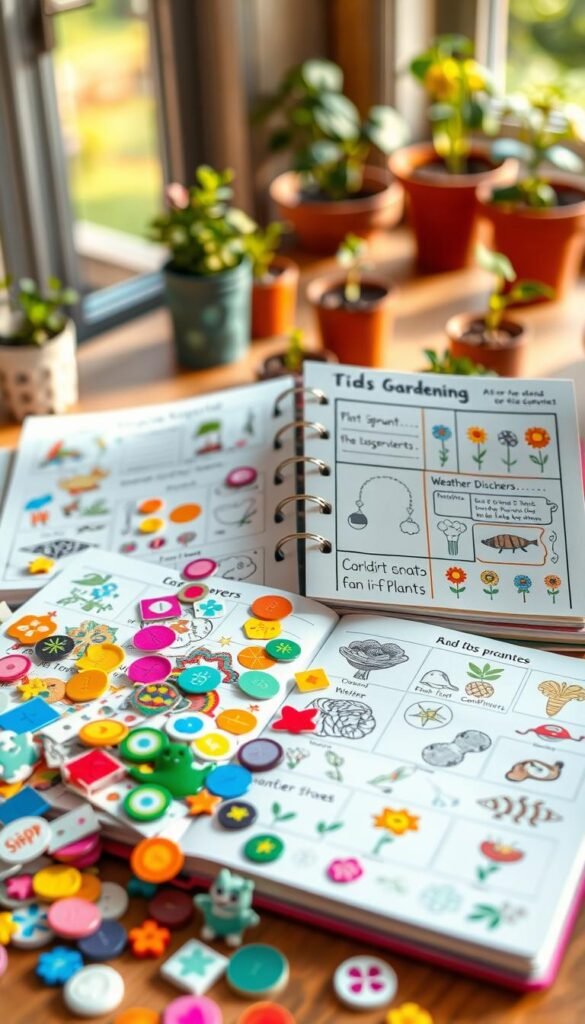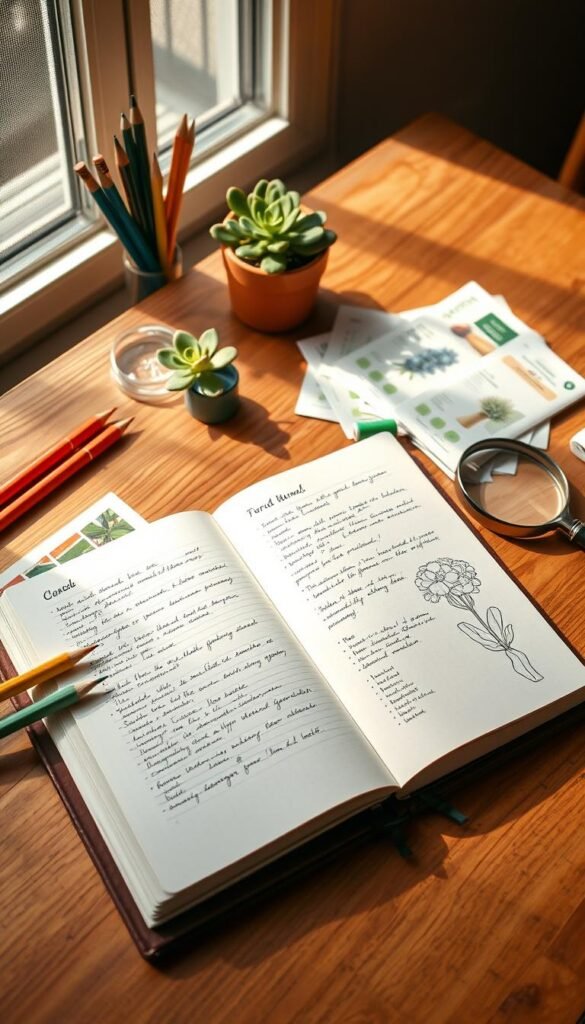Imagine having a colorful companion that captures every sprout, bloom, and seasonal shift in your garden. A dedicated journal turns gardening into an adventure, blending creativity with practical observations. Whether sketching new leaves or jotting down planting dates, this tool helps young growers understand their plants while building lasting memories.
Why does this matter? Documenting details like weather patterns or pest activity creates a reference guide for future years. Think of it as a personalized almanac—similar to seasonal care tips for square-foot gardens—but tailored to your child’s curiosity. Pages filled with doodles, stickers, or pressed flowers make revisiting information feel like flipping through a storybook.
Not sure where to begin? Start simple. Track sunlight hours or soil changes weekly. Compare how different plants respond over times. These small steps teach patience and attention to detail. Plus, reviewing past entries sparks excitement when seedlings finally bloom!
Ready to dive in? Grab a notebook, some markers, and let the garden adventures unfold. With each entry, your little gardener will uncover the magic of nurturing life—one season at a time.
Introducing the World of Kids Gardening Journals

Picture a space where dirt-stained hands meet colorful markers, transforming ordinary observations into vibrant stories. A garden journal bridges play and learning, letting kids document their green adventures in a personalized way. Unlike standard notebooks, these journals blend sketches, weather notes, and playful prompts to make every page a discovery.
Why Gardening Journals Inspire Young Gardeners
When children track daily changes—like a sprout’s height or rainfall patterns—they begin to see patterns in nature. This turns routine tasks into exciting detective work. Did the tomatoes grow faster after a sunny week? Why did the marigolds wilt? A journal answers these questions while teaching responsibility.
The Benefits for Your Child’s Growth and Creativity
Beyond dirt and seeds, journaling builds skills. Organizing entries sharpens focus. Drawing plants boosts artistic confidence. Even simple charts for sunlight or soil pH turn science into hands-on fun. Over time, their notebook becomes a scrapbook of progress, filled with pressed petals or doodles of buzzing bees.
| Approach | Features | Benefits |
|---|---|---|
| Daily Logs | Weather notes, growth measurements | Teaches consistency |
| Sketch Sections | Plant drawings, garden layouts | Encourages creativity |
| Weather Trackers | Rainfall, temperature charts | Improves data analysis |
Want to expand the experience? Pair journaling with collaborative projects in local green spaces. Sharing ideas with peers adds social learning to the mix. Whether planning next season’s layout or comparing soil conditions, this practice nurtures both curiosity and community.
How to Start a Kids Gardening Journal: Tracking Growth & Discoveries

Your child’s garden journey deserves a special place to blossom—both in the soil and on paper. Choosing between a printed journal and digital apps depends on your family’s style. Physical notebooks with thick, waterproof pages handle outdoor messes better, while apps offer cloud backups for weather-stained days.
Selecting the Right Journal and Gardening Supplies
Start with a spiral-bound notebook—it lies flat for easy sketching. Pair it with washable markers or colored pencils for vibrant plant doodles. Add sticky notes for quick dates or reminders. For tech-loving families, try apps like Gardenize, which sync planting schedules across devices.
Include a pocket folder in the journal for seed packets or space-saving vegetable tags. Stamps with sun or raindrop icons make tracking seasons playful. A ruler printed on the journal’s edge helps measure sprouts without extra tools.
Setting Up a Layout That Works for You and Your Kids
Divide pages into thirds: one section for sketches, another for notes, and a sidebar for weekly goals. Use colored tape to create zones—blue for weather logs, green for growth charts. A monthly calendar grid tracks planting dates, while blank spaces invite pressed leaves or bug drawings.
Save two pages for winter planning. Sketch next year’s layout or list crops to try. This keeps excitement alive during colder months. Rotate tasks weekly—one day for data, another for art. Balance keeps young minds engaged without overwhelming them.
Organizing Your Journal for Effective Growth Tracking

Ever wonder how a well-organized journal can turn garden chaos into clarity? Structured layouts help young gardeners spot patterns, adjust care routines, and celebrate progress. By dividing entries into focused categories, you’ll create a roadmap that turns scattered notes into actionable insights.
Documenting Planting Dates and Seasonal Changes
Start by reserving two pages for a calendar grid. Mark seed-starting dates, transplant days, and first harvests. Use colored dots to indicate seasonal milestones—orange for fall bulb planting, green for spring pruning. Comparing these dates year-over-year reveals ideal time frames for your microclimate.
Track moon phases or temperature shifts alongside plant growth. Did basil thrive during warmer nights? Did carrots stall in cooler soil? These connections turn guesswork into guided learning. For inspiration, explore creative garden journal ideas that blend practicality with play.
Incorporating Weather and Soil Details into Your Notes
Dedicate a sidebar to daily weather snapshots. Sketch cloud types or glue raindrop-shaped stickers for precipitation days. Note wind direction with arrows—it affects pest movement and pollination rates.
Test soil moisture weekly using a simple finger-check system. Create a 1–5 scale: 1 (dusty) to 5 (muddy). Pair this with pH strip results in a mini chart. Over time, these records explain why certain plants flourish while others struggle.
| Section | Tools | Impact |
|---|---|---|
| Calendar Grid | Colored markers, stickers | Visualizes growth timelines |
| Weather Tracker | Ruler, symbols | Links climate to plant health |
| Soil Log | Sticky notes, charts | Guides fertilization plans |
Rotate tasks every few days to maintain interest—Monday for measurements, Thursday for sketches. This rhythm keeps the journal fresh without feeling like homework. Soon, your child will instinctively reach for their notebook after watering, eager to document today’s tiny wonders.
Creative Ways to Enrich Your Gardening Journal

What if every page of your garden journal could bloom with personality? Transform blank sheets into vibrant storyboards by blending plant sketches, playful stickers, and heartfelt notes. This approach turns routine entries into keepsakes that grow alongside your garden.
Adding Drawings, Stickers, and Personal Reflections
Glue seeds or pressed petals beside their sprouted versions to show life cycles. Use washi tape to create borders around vegetable garden layouts. Try leaf rubbings—place a leaf under the page and shade with crayons for instant botanical art.
Assign a “mood meter” for plants. Draw faces on tomatoes (😊 for healthy, 🥱 for drooping). Stickers with raindrops or suns make keeping track of weather fun. Add pockets made from recycled seed packets to store clippings or photos.
Using Interactive Prompts to Spark Curiosity
Paste prompts like “What made my plant smile today?” or “Three colors I spotted in the soil.” These ideas encourage deeper observation. Create a scavenger hunt page: “Find a heart-shaped leaf” or “Spot a bug wearing stripes.”
Try “growth guess” games. Measure a sprout, then draw how tall they think it’ll be next week. Wrong answers become funny memories. Use arrow stickers to map seeds’ underground journeys before they emerge.
| Creative Element | Materials Needed | Learning Outcome |
|---|---|---|
| Seed Collages | Glue, mixed seeds | Identifies seed varieties |
| Weather Stamps | Ink pads, nature stamps | Links climate to growth |
| Plant Diaries | Speech bubble stickers | Encourages empathy |
Rotate between facts and fantasy. One day, post exact measurements of beanstalks. Next, write a poem from the carrot’s perspective. This balance makes the thing you’re tracking—whether pH levels or ladybug visits—feel magical and meaningful.
Final Reflections on Your Garden Journey
As seasons change, your garden’s story unfolds—one page at a time. Those scribbled details—first sprouts, surprise blooms, even stubborn pests—transform into a treasured map of growth. Over years, these records become more than notes; they’re time capsules showing how tiny seeds evolve into thriving plants.
Whether you choose paper notebooks or digital tools, each option preserves memories while sharpening skills. Flipping through past entries reveals patterns: maybe carrots thrive in April showers, or sunflowers lean westward yearly. These insights shape smarter planting choices next year.
Don’t wait for perfection—get started with a single observation. Jot down today’s weather, sketch a leaf, or list three colors spotted among blooms. Consistency matters more than complexity. Even messy pages bursting with stickers hold lessons for future plots.
Your journal isn’t just about gardening—it’s where curiosity roots and patience blooms. With every entry, you’re not only nurturing plants but cultivating a lifelong dialogue with nature’s rhythms.





